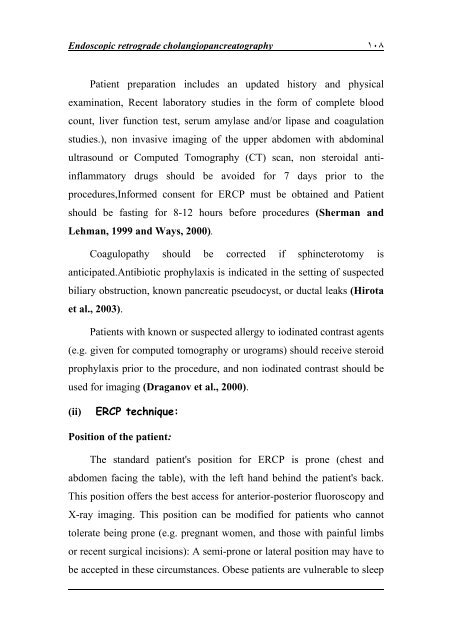Parasites and Biliary stones
Parasites and Biliary stones
Parasites and Biliary stones
You also want an ePaper? Increase the reach of your titles
YUMPU automatically turns print PDFs into web optimized ePapers that Google loves.
Endoscopic retrograde cholangiopancreatography ١٠٨<br />
Patient preparation includes an updated history <strong>and</strong> physical<br />
examination, Recent laboratory studies in the form of complete blood<br />
count, liver function test, serum amylase <strong>and</strong>/or lipase <strong>and</strong> coagulation<br />
studies.), non invasive imaging of the upper abdomen with abdominal<br />
ultrasound or Computed Tomography (CT) scan, non steroidal anti-<br />
inflammatory drugs should be avoided for 7 days prior to the<br />
procedures,Informed consent for ERCP must be obtained <strong>and</strong> Patient<br />
should be fasting for 8-12 hours before procedures (Sherman <strong>and</strong><br />
Lehman, 1999 <strong>and</strong> Ways, 2000).<br />
Coagulopathy should be corrected if sphincterotomy is<br />
anticipated.Antibiotic prophylaxis is indicated in the setting of suspected<br />
biliary obstruction, known pancreatic pseudocyst, or ductal leaks (Hirota<br />
et al., 2003).<br />
Patients with known or suspected allergy to iodinated contrast agents<br />
(e.g. given for computed tomography or urograms) should receive steroid<br />
prophylaxis prior to the procedure, <strong>and</strong> non iodinated contrast should be<br />
used for imaging (Draganov et al., 2000).<br />
(ii) ERCP technique:<br />
Position of the patient:<br />
The st<strong>and</strong>ard patient's position for ERCP is prone (chest <strong>and</strong><br />
abdomen facing the table), with the left h<strong>and</strong> behind the patient's back.<br />
This position offers the best access for anterior-posterior fluoroscopy <strong>and</strong><br />
X-ray imaging. This position can be modified for patients who cannot<br />
tolerate being prone (e.g. pregnant women, <strong>and</strong> those with painful limbs<br />
or recent surgical incisions): A semi-prone or lateral position may have to<br />
be accepted in these circumstances. Obese patients are vulnerable to sleep
















